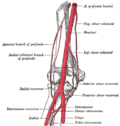Interosseous recurrent artery: Difference between revisions
CSV import |
CSV import Tags: mobile edit mobile web edit |
||
| Line 27: | Line 27: | ||
[[Category:Anatomy]] | [[Category:Anatomy]] | ||
[[Category:Medical terminology]] | [[Category:Medical terminology]] | ||
<gallery> | |||
File:Gray420.png | |||
File:Gray526.png | |||
</gallery> | |||
Latest revision as of 01:53, 17 February 2025
Interosseous recurrent artery is an artery in the human body that originates from the posterior interosseous artery. It is also known as the recurrent interosseous artery or recurrent artery of the forearm.
Etymology[edit]
The term "interosseous" is derived from the Latin words "inter", meaning "between", and "osseus", meaning "bony". The term "recurrent" is derived from the Latin word "recurrens", meaning "running back". Therefore, the term "interosseous recurrent artery" can be interpreted as the artery that runs back between the bones.
Anatomy[edit]
The interosseous recurrent artery arises from the posterior interosseous artery, just before it penetrates the interosseous membrane. It ascends in the direction of the elbow, supplying the contiguous muscles, and anastomosing with the middle collateral artery.
Function[edit]
The main function of the interosseous recurrent artery is to supply blood to the muscles in the forearm. It also plays a role in the anastomosis (connection) between the blood vessels in the forearm and elbow.
Clinical significance[edit]
In clinical practice, the interosseous recurrent artery is important in surgical procedures involving the forearm and elbow. Its knowledge is crucial in preventing inadvertent injury during surgery and in planning vascular reconstructions.
See also[edit]
References[edit]
<references />




